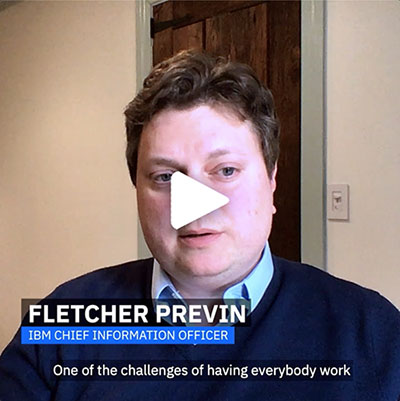IBM and Coronavirus stories
IBM CIO Fletcher Previn: Supporting collaboration in the era of remote work

Play highlights from Previn's presentation
As Chief Information Officer of IBM, Fletcher Previn understands the burdens now shouldered by IT leaders.
Previn oversees a department of 12,000 IT pros and is responsible for the management of more than 500 data centers, 480,000 laptops and 220,000 mobile devices – one of the biggest tech operations aside from the U.S. federal government. He is now handling the technological side of an unprecedented shift in labor as most of IBM’s 350,000 employees must now conduct business from their homes.
To keep IBM running in this widescale remote environment, Previn intends to balance the demands of business continuity with his goal of fostering the company’s culture, even with employees physically separated. As CIOs try to make sense of new expectations during these trying times, he offers advice on how IT can prevent technical problems while providing remote employees with modern collaborative work tools.
Previn has heard from hundreds of CIOs and business leaders over the past few weeks, all of whom are facing unprecedented IT challenges from the COVID-19 pandemic. The most frequent of their questions were answered in his recent webinar, “Adapting Your Infrastructure to Remote Work,” the first in IBM’s Think Leadership series, where IBM leaders share their experiences and insights from managing the impact of COVID-19.
The main task, in Previn’s view: "CIOs have an opportunity during the pandemic to keep their organizations together, navigate stresses and strains, and help employees come out the other side.” Following are Previn's answers to some of the most frequent questions he gets from IBMers and from clients.
→ For more on this topic, please see the report “A CIO’s Guide to Extreme Challenges” from the IBM Institute for Business Value.
Which remote working tools does IBM use, and which would you recommend to other CIOs?
Employee safety is our paramount concern and during this pandemic we’re relying on an internal tool, IBMer Safe, that we already had in place. It allows employees to voluntarily check-in with their managers to let them know they are safe or need help after a natural disaster, power shutdown or other emergency. As for day-to-day collaboration and productivity, we’re turning to the tools that have served us well: Slack, WebEx, GitHub, Trello and many other Software as a Service products that are resilient and scalable and can mitigate risk. We’re also taking advantage of our Red Hat OpenShift container platform as well as Linux. Containers and open source allow our development teams to easily move workloads across cloud environments.
I’d advise CIOs to implement tools that embrace modern ways of work and are agile. Do the tools make it easy to have a meeting? Share files? File an expense report? Onboard an employee? That goes for all technologies that enable remote work.
Technical literacy varies from employee to employee, but now almost every employee working remotely has to rely on technology. How can IT scale its company’s tech capabilities while ensuring everyone can easily use them?
I would love it if everyone at IBM was technically savvy, but you have employees in positions that don’t demand advanced technical prowess. They need only tools that help them get their jobs done.
The more time that a CIO can invest up front to study the influence of technology, the less time that will be spent on solving problems later. Nobody came to my house to teach me how to use Facebook or LinkedIn. Similarly, the provisioning of any new technology should make things easier for employees. I’d rather invest time and money in technology that employees can figure out on their own and explore without trepidation. When we are successful with that, we don’t have to push the technology. Instead, employees pull it into their daily routines.
How do you deal with the challenge of leading remote teams?
When you’re working in an office, it’s easy to have impromptu interactions with colleagues and build friendships. You’re able to make deposits in that “relationship account,” and those bonds carry over into work. If you don’t make an effort to have a virtual equivalent of those interactions, relationships will devolve into purely transactional ones. You’re then making only withdrawals from that relationship account. The bonds with people who had been like family will break.
The biggest challenge of remote work will be keeping those relationships intact. You have to make that extra effort. Reach out and call people. Have unscheduled interactions and stay involved in their lives. Once CIOs get past the initial flurry of ensuring everyone has remote access and can do their jobs, they then should shift into the cultural component of leadership. In these times, especially, you want to maintain the health and vitality of the company. CIOs have an opportunity during the pandemic to keep their organizations together, navigate stresses and strains and help employees come out the other side.
If remote work is the new norm, what is the long-term outlook for IT?
We’re all learning a lot. We are not in ideal circumstances, obviously. People are suffering.
But we are learning what types of roles are enhanced or diminished by working remotely. After the pandemic ends, we will have a better understanding of which jobs benefit from being in the office and which jobs work better remotely.
We won’t just return to the way things were. With a better appreciation of jobs in different environments, we’ll know which technologies will deliver the benefits of working alongside bright people who aren’t in the same building.
→ Visit the IBM News Room's complete coverage of IBM's response to the coronavirus pandemic.
→ See the full lineup of the IBM Think Leadership Livestream series.
→ Watch a replay of Fletcher Previn's full webinar — click below.
